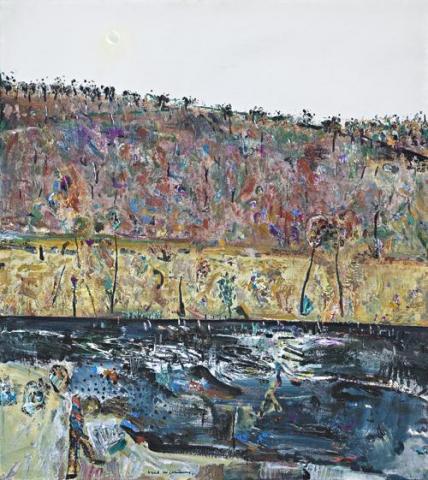INDIGO POOL, 1977-78
Fred Williams
oil on canvas
96.0 x 86.0 cm
signed lower centre: Fred Williams.
Estate of the artist, Melbourne
Private collection, Sydney since 1989
Fred Williams 1969-1979 Oeuvres, Australian Embassy, Paris, 10 April-2 May 1980, cat.9; and touring the Bordeaux region in France before travelling to London
Fred Williams: Landscapes 1969-1979, Fischer Fine Art Limited, London, 16 May-13 June 1980, cat.9 (label attached verso)
Fred Williams painted Indigo Pool on the Lederderg River not far from Bacchus Marsh, some fifty-four kilometres west of Melbourne. The date was probably 11 May 1977. Williams had only recently returned from his prestigious and highly successful exhibition at New York's Museum of Modern Art. Painted on site, it was worked on and finished later in his studio. Although the label on the back of the painting gives the date as '1978', Lyn Williams believes that a more correct dating is 1977-78, basing this on Fred's diary entry for this work.1 Williams had been painting in the Bacchus Marsh area for some time, frequenting the nearby Werribee National Park which inspired his Werribee Gorge series of 1976-77. Together with the slightly earlier Kew Billabong series, they witnessed the richest of change, introducing a palette with the colours of the rainbow to enthral the viewer. Indigo Pool is a felicitous example, the eye being drawn as much by the depths of the indigo as the surface sparkle of whites. In the colour spectrum, indigo falls between deep blue and violet. Williams uses the colour motif like a musical theme, moving blues into mauves and purples, and weaving them through the composition in moments resonant and subtle. This use of a dark indigo occurs in other paintings of the time, reaching a brilliant crescendo in the Waterfall Polyptych, 1979, in the collection of the Art Gallery of New South Wales. As in music, the different horizontal sections of Indigo Pool provide the separate movements of the composition; while the surface dances with the brilliance of the technique, smooth passages contrasted with textured highlights. As in so much of his work, one senses that this image is but part of the ongoing creation, the endless flow of the landscape on either side limited only by the edges of the canvas. Williams captured the peculiarity of the Australian landscape, transforming its seeming monotony through his brilliant and expressive talent. Colour is used as form, with vivid touches of red and oranges against cooler hues and defining blacks. One is attracted as much by the textural beauty of its surfaces as the inventive imagery, of the lively movement of the flowing waters of the pool, or the calm seduction of the sky, an old moon sitting in the arm of the new. The evident quality of the painting aside, Williams thought so highly of it that he included it in his prestigious exhibition shown in Paris and London in 1980.
1. Lyn Williams, 13 October 2007
We are grateful to Lyn Williams for her assistance with the cataloguing of this work.
DAVID THOMAS
